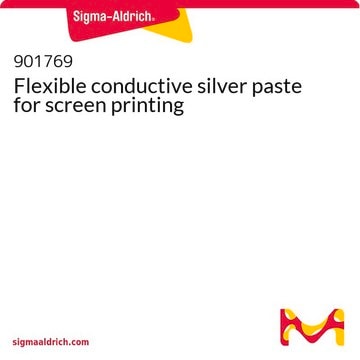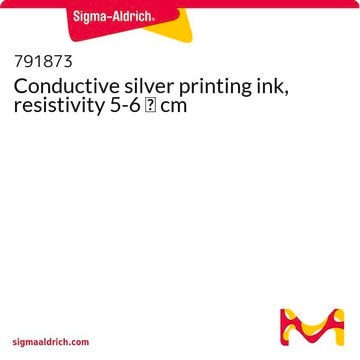This platinum paste has initially been developed as a screen printing paste to obtain a highly conductive and “catalytic” amount of platinum when printed on a transparent substrate (glass, plastics), while allowing the substrates to maintain their transparency after deposition and annealing. The concentration of platinum is therefore quite low (<1%), and the screen printed layer is usually quite thin. Any changes to the product would be for the researcher to experiment with. This paste must be fired at or above 420°C and any modifications made to the product does void the performance guarantee.
791512
Platinum paste, screen printable
Synonyme(s) :
Greatcell Solar PT1 platinum paste, Pt paste, conductive paste
Sélectionner une taille de conditionnement
163,00 €
Sélectionner une taille de conditionnement
About This Item
163,00 €
Produits recommandés
Forme
paste (Amber)
Niveau de qualité
Viscosité
2500-4500 mPa.s (Analysis carried out at 20°C with 20mm 4 degree cone/plate; 40 s-1)
Température de stockage
2-8°C
Chaîne SMILES
[Pt]
InChI
1S/Pt
Clé InChI
BASFCYQUMIYNBI-UHFFFAOYSA-N
Catégories apparentées
Application
PT1 Platinum Paste is oil-based and formulated to be applied using a screen printer; providing films with excellent uniformity; performance and reproducibility; and can be used for DSSC polot production.
After drying; this paste must be fired at or above 420°C. This results in uniformly distributed platinum nanoclusters; providing good transparency and high catalytic activity for the electrochemical reduction of I3- to I-.
Suggested Mesh Screen: 100T
Informations légales
Greatcell Solar is a registered trademark of Greatcell Solar Materials Pty Ltd
Mention d'avertissement
Danger
Mentions de danger
Conseils de prudence
Classification des risques
Eye Dam. 1 - Resp. Sens. 1 - Skin Irrit. 2 - Skin Sens. 1
Code de la classe de stockage
10 - Combustible liquids
Classe de danger pour l'eau (WGK)
WGK 1
Point d'éclair (°F)
194.0 °F
Point d'éclair (°C)
90 °C
Faites votre choix parmi les versions les plus récentes :
Déjà en possession de ce produit ?
Retrouvez la documentation relative aux produits que vous avez récemment achetés dans la Bibliothèque de documents.
Les clients ont également consulté
Articles
Dye-sensitized solar cells (DSCs) are 3rd generation solar cells combining the promise of high efficiency with low production costs.
While dye sensitization as the basis for color photography has been accepted for a very long time,1 attempts to use this principle for the conversion of solar light to electricity generally had resulted only in very low photocurrents, below 100 nA/cm
Professors Tokito and Takeda share design principles and optimization protocols for organic electronic devices, focusing on flexibility and low cost.
Progress in solution-processed functional materials leads to thin-film optoelectronic devices for industrial and consumer electronics.
-
Can the paste be thinned using solvent? If so, which? Also, will be paste become solid if cured underneath the 420degC temperature? And would it adhere to a polymer substrate? Thanks!
1 answer-
Helpful?
-
-
Does it work as a conductive paste? Do you have the resistivity of the paste?
1 answer-
Unfortunately, Product 791512 has not been tested for its properties in terms of conductivity or resistivity. Rather, it was developed for its catalytic properties.
Helpful?
-
Active Filters
Notre équipe de scientifiques dispose d'une expérience dans tous les secteurs de la recherche, notamment en sciences de la vie, science des matériaux, synthèse chimique, chromatographie, analyse et dans de nombreux autres domaines..
Contacter notre Service technique











